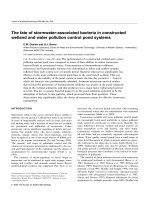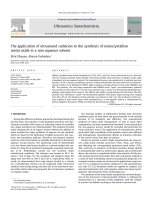The application of NARX neural networks in identification electric drive control system
Bạn đang xem bản rút gọn của tài liệu. Xem và tải ngay bản đầy đủ của tài liệu tại đây (937.56 KB, 6 trang )
Kỹ thuật Điều khiển – Tự động hóa
THE APPLICATION OF NARX NEURAL NETWORKS
IN IDENTIFICATION ELECTRIC DRIVE CONTROL SYSTEM
Nguyen Duc Thanh1, Doan Van Thuy1, Tran Huu Phuong2*
Abstract: This paper deals with an identification model control system using
recurrent neural networks to estimate the angle main mirror in azimuth moving of
large radio telescope electric servo drive. The architectural approached to design
recurrent neural networks based on “Nonlinear Auto Regressive with Exogenous
inputs – NARX models” is analyzed. It is convenient to apply this design in the field
of prediction and modeling control system. During computer simulation, the
performances of neural network identification model with different parameters are
compared in the working of electric drive control systems. In this work, designing,
training, testing of neural networks identification model are carried out by Matlab/
SIMULINK environment.
Keywords: Large radio telescope; System identification; Artificial neural networks; Model NARX.
1. INTRODUCTION
System identification techniques are fundamental methods in theory of automatic
control systems. System identification in control engineering is the process to design a
model mathematical description Fˆ (u) adequate fitted plant structure F (u) based on
known input vector u(k ) and observed output vector y (k ) from the real plant system,
with k 1, 2, , N (fig. 1)
y yˆ F (u) Fˆ (u) e ,
(1)
where e is mean square error (MSE), defined by the norm ; yˆ ( k ) Fˆ (u) is output
vector of identification model; u( k ) is vector allowable control input signal.
y (k 1)
F (u)
e
u(k )
Fˆ (u)
yˆ (k 1)
Fig. 1. System identification.
The process of identification model Fˆ (u) depends on collecting data, note that the
experiment should be constructed, such that the data collected adequately describes the
process. The process should be subjected to a sufficient number of inputs, so that an
accurate relationship between input and output can be obtained. Finally, validating the
identification model involves assessing how well the model replicates the observed data.
From a historical point of view, before the 1980s, identification of dynamic systems
used linear parametric autoregressive (AR), moving-average (MA) and autoregressive
moving-average (ARMA) models introduced by Box and Jenkins. These models are linear
and are not able to cope with certain non-stationary signals, and signals whose
mathematical model is not linear. In recent years, artificial neural networks (ANNs) have
58 N. D. Thanh, D. V. Thuy, T. H. Phuong, “The application of NARX … drive control system.”
Nghiên cứu khoa học công nghệ
been known as powerful mathematical computational tools, well approach to control
technical object. ANNs can be classified in two typical tasks, one of which is the choice of
optimal structure of the ANNs and the other is building an effective learning algorithm
which they use for weight updates [3]. In the field of system identification, a model
control process in the form of ANNs is developed to estimate (forecast) the output values
in the future.
2. THE NARX NEURAL NETWORKS IDENTIFICATION
In traditional system identification, model structure must be defined a prediction to
estimate all required system parameters. In case of large radio telescope servo drive,
defining a predictive model is difficult to implement. With ANNs, it is capable of
identifying underlying relationship between the given input and output data. Fig. 2 is an
ANNs identification system is used in this paper. We propose a modern approach
architectural ANNs based on “Nonlinear Autoregressive models with Exogenous inputs NARX model”, which are therefore called NARX recurrent neural networks in seriesparallel mode [2]. Such networks can be expanded by nonlinear equation as following
yˆ (k 1) Fˆ u (k ), u (k 1), , u (k d1 ) , y (k ), y (k 1), , y (k d 2 ), ,
(2)
where Fˆ (u , y ) is input-output conversional function performed by the ANNs; d1 is input
tapped delay line; d2 is output tapped delay line.
The NARX model for approximation of a function Fˆ (u , y ) can be implemented in
many ways, but the simpler seems to be by using a feedforward neural network with the
embedded memory. As is shown in fig. 2, the plant produces output y (k 1) and it is
approximated by output of identification model yˆ (k 1) with a one-step-ahead prediction
because of the series-parallel configuration. Plant and identification model have the same
input u ( k ) . In this work, u ( k ) is angular azimuth axis data, y (k 1) is angle encoder
output data on the main mirror of the antenna, yˆ (k 1) is predictive value of the output in
the ANNs mode, e(k 1) is predictive error which y (k 1) is compared with yˆ (k 1) .
y (k 1)
e(k 1)
u (k )
u (k 1)
z 1
u (k d1 )
z 1
y (k d 2 )
z 1
y (k 1)
z 1
yˆ (k 1)
Fig. 2. Schematic diagram NARX model in series-parallel mode.
Let’s regard an experiment of using NARX model to design an identification model in
process of estimation angle main mirror in azimuth moving of the large radio telescope 70m parabolic antenna diameter (the RT-70 antenna). In [1], [4], we introduced augmented
mathematical model of electric servo drive of the RT-70 antenna in system of four-mass
branched elastic model with concentrated parameters. This model is written in discretetime state-space with sampling interval Ts , as
Tạp chí Nghiên cứu KH&CN quân sự, Số Đặc san FEE, 08 - 2018
59
Kỹ thuật Điều khiển – Tự động hóa
x(k 1) Ax(k ) Bu(k )
,
y (k ) Cx(k )
(3)
with coordinates
x ω1
M 21 ω2
M 32
ω3
M 42
ω4
T
im 3 ,
where ω1 , ω2 , ω3 , ω4 are speeds of each mass; M m , M 21 , M 32 , M 42 are moment’s motor
and moments elastic between masses; im is current motor; y (k ) φ3 is vector output
(angle main mirror in azimuth moving of the RT-70 antenna). In position loop has discrete
model predictive controller based on Laguerre functions [5] (MPC-Laguerre regulator).
Structural diagram of the RT-70 antenna electrical servo drive control system is shown in
fig. 3 and its parameters are described in detail in [4]. This structure includes the Discrete
State Space Plant, the MPC-Laguerre Predictive Controller block, the NARX Neural
Network-NNET block, and the Graph.
Fig. 3. Scheme of the RT-70 antenna servo control system in Simulink.
In this experiment, we carried out a computation by using the Neural Network Time
Series Tool to design standard NARX architecture. NARX model uses a feedforward
neural network to approximate the function Fˆ (u , y ) . A diagram of the resulting network
is shown below (fig. 4), where a two-layer feedforward network is used for the
approximation. This implementation also allows for a vector ARX model, where the input
and output can be multidimensional. In the hidden layers, the nonlinear sigmoidal
activation functions are taken, whereas in the output layer, the linear activation function is
used. During the training procedure, the backpropagation method is applied.
Fig. 4. Architecture of the NARX neural network in Neural Network Time Series Tool.
3. SIMULATION RESULTS
In this considered case, ANNs are used to estimate the angle main mirror in azimuth
moving of the RT-70 antenna electrical drive. The optimal output signal of MPC-Laguerre
60 N. D. Thanh, D. V. Thuy, T. H. Phuong, “The application of NARX … drive control system.”
Nghiên cứu khoa học công nghệ
position regulator, angle encoder output data of main mirror and external disturbance
(wind flow) such as "white noise" are chosen as input signals of these ANNs structure.
The angle main mirror in azimuth moving varies in the range from 0 '' to
36000 '' (arcseconds) with resolution is 2 '' . The duration of model simulation is 30
minutes. The drive system of the RT-70 antenna suffers under wind disturbance with its
average flow speed is 10 m/s. Amplitude of external disturbances was taken equal to 10%
of maximum useful value signal. The number of training data ANNs is 180 000 samples.
The simulations are carried out using the Matlab/SIMULINK R2016a with sampling
interval Ts 102 sec.
To investigate the influence of input parameters to the quality estimation accuracy of
angle main mirror, the different input parameters of ANNs are composed and will be
change in 3 variants. The changed parameters are following:
1) the predictive horizon of MPC- Laguerre regulator, N p ; 2) training function; 3)
tapped delay line, d d1 d 2 ; 4) structure of the NARX model with different numbers of
neurons at hidden layers.
First, we select 3 values predictive horizon of the MPC-Laguerre regulator [5] and test
them in separately each:
1) N p 30 ; 2) N p 106 ; 3) N p 68 .
Then, to test quality of identification model, we give 3 training functions
backpropagation:
1) trainscg – scaled conjugate gradient backpropagation; 2) trainbr – Bayesian
regularization backpropagation; 3) trainlm – Levenberg - Marquardt backpropagation.
The different input vectors of ANNs are composed of the actual and tapped delay line:
1) when d 1 , the NARX model is described in the form
yˆ (k 1) Fˆ u (k ), u (k 1), φ3 (k ), φ3 (k 1) ;
(4)
2) when d 2 , the NARX model is described in the form
yˆ (k 1) Fˆ u (k ), u (k 1), u (k 2), φ3 (k ), φ3 (k 1), φ3 (k 2) ;
(5)
3) when d 3 , the NARX model is described in the form
yˆ (k 1) Fˆ u(k ), u(k 1), u(k 2), u(k 3),φ3 (k ),φ3 (k 1),φ3 (k 2),φ3 (k 3) . (6)
The following, structures of the NARX model with different number neurons in hidden
layers are tested:
1) x 2 1
(7);
2) x 4 1
(8);
3) x 10 1
(9).
where the number ANNs model input nodes x depends on the kind of input vector
according to (4) – (6).
After the composing with 3 variants, the ANNs identification models are trained and
tested. we obtain the following diagrams: servo tracking position responses of the RT-70
antenna, corresponding to angle main mirror set point p 20 '' and the MSE estimation
angle graphs between the reaction of the plant and the output of identification model
e φ3 φ3id . Identification estimation errors are shown and compared, according to fig.
Tạp chí Nghiên cứu KH&CN quân sự, Số Đặc san FEE, 08 - 2018
61
Kỹ thuật Điều khiển – Tự động hóa
5. a), b) is the first variant; fig. 6. a), b) is the second variant; fig. 7. a), b) is the third
variant of the experiment.
5.a) Servo tracking position response
5.b) MSE estimation angle main mirror
Fig. 5. The first variant of identification results.
6.a) Servo tracking position response
6.b) MSE estimation angle main mirror
Fig. 6. The second variant of identification results.
7.a) Servo tracking position response
7.b) MSE estimation angle main mirror
Fig. 7. The third variant of identification results.
From the analysis of the obtained estimation errors, it is clearly visible that the type
input parameters of ANNs has a big influence on the estimation quality of both servo
tracking position responses and MSE estimation angle values main mirror of the RT-70
antenna. The system in the first variant with the simplest input parameter (according to (4)
and (7)) cannot estimate angle values main mirror accurately. The MSE estimation angle
main mirror are about 0.5% of the values angle main mirror (fig. 5.a and fig. 5.b). The
MSE estimation error is much better in the third variant (fig. 7.a and fig. 7.b), especially
the ANNs with training function Levenberg - Marquardt backpropagation.
4. CONCLUSION
In this paper, the approach to identification systems using NARX model artificial
neural networks were presented. The performances of servo tracking position response and
MSE estimation angle main mirror of the RT-70 antenna control system with different
62 N. D. Thanh, D. V. Thuy, T. H. Phuong, “The application of NARX … drive control system.”
Nghiên cứu khoa học công nghệ
parameters of identification model were tested. Our work determined well validation of
the application of using ANNs for identification system of the RT-70 antenna electrical
servo control system.
REFERENCES
[1]. Tran Huu Phuong, Nguyen Duc Thanh, Nguyen Manh Tuan, “Управление
электроприводом крупного радиотелескопа с линейно-квадратичным
гауссовским регулятором,” Tạp chí Nghiên cứu Khoa học và Công nghệ quân sự,
số 50, xuất bản tháng 2, năm 2018, Tr. 28-37.
[2]. A. O. Vedyakova, “ Identification under external disturbance conditions using neural
networks,” International Journal of Open Information Technologies, vol. 2, 2014, №3,
pp. 18-22.
[3]. K. S. Narendra, K. Parthasarthy, “Identification and control of dynamical systems
using neural networks,” IEEE Trans. Neural networks, vol. 1, 1990, P. 4-26.
[4]. Tran Huu Phuong, Belov M. P., Tran Dang Khoa, “Model Predictive Controller
Based on Laguerre Functions for Large Radio Telescope Servo Control System”, In
2018 IEEE NW Russia Young Researchers in Electrical and Electronic Engineering
Conference (ElConRusNW). 2018. P. 1003–1007
[5]. L. Wang, “Discrete model predictive control design using Laguerre functions.”
Journal of Process Control 14, 2004, pp. 13-42.
TÓM TẮT
ỨNG DỤNG MẠNG NƠ-RON NARX TRONG BÀI TOÁN NHẬN DẠNG
HỆ THỐNG ĐIỀU KHIỂN TRUYỀN ĐỘNG ĐIỆN TỰ ĐỘNG
Bài báo phân tích kiến trúc và mô hình toán của mạng nơ-ron ngược - mô hình
NARX. Đây là một kiến trúc mạng nơ-ron có thế mạnh trong các bài toán mô phỏng
và nhận dạng các hệ thống điều khiển truyền động điện tự động. Trong bài báo, các
tác giả đề xuất một phương pháp ứng dụng thuật toán nhận dạng hệ thống điều
khiển dựa vào mạng nơ-ron ngược NARX để ước lượng góc quay theo kênh phương
vị của kính thiên văn vô tuyến cỡ lớn. Khi thực hiện mô phỏng trên máy tính, các
tính chất của mô hình nhận dạng mạng nơ-ron được so sánh qua các chỉ tiêu về quá
trình quá độ và sai số của bộ nhận dạng. Việc thiết kế, huấn luyện, thử nghiệm mô
hình nhận dạng mạng nơ-ron được thực hiện trên môi trường Matlab / SIMULINK.
Từ khóa: Kính thiên văn vô tuyến cỡ lớn; Nhận dạng hệ thống điều khiển; Mạng nơ-ron nhân tạo; Mô hình
NARX.
Nhận bài ngày 01 tháng 7 năm 2018
Hoàn thiện ngày 10 tháng 9 năm 2018
Chấp nhận đăng ngày 20 tháng 9 năm 2018
Author affiliations:
1
Institute of Military Science and Technology;
2
Saint-Petersburg Electrotechnical University “LETI”, St. Petersburg, Russia.
*
Corresponding author:
Tạp chí Nghiên cứu KH&CN quân sự, Số Đặc san FEE, 08 - 2018
63









